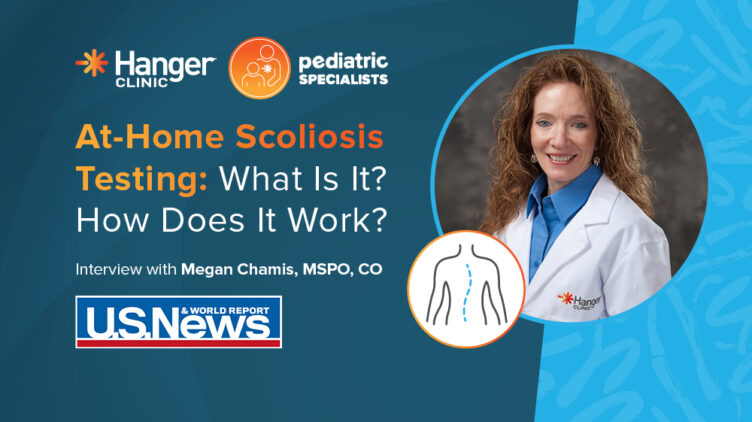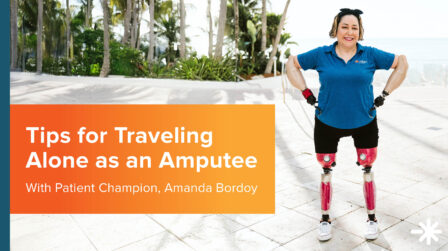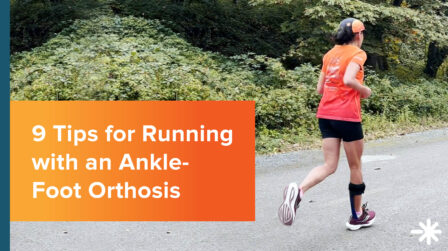US News and World Report and Pediatric Specialist Megan Chamis Share Importance of Scoliosis Identification and Treatment

Scoliosis is a curvature of the spine that affects about 2 to 3 percent of the population and is most commonly diagnosed in adolescence. To help educate the public about the condition, US News and World Report interviewed several national scoliosis experts including Hanger Clinic Pediatric Specialist and longtime orthotist Megan Chamis about the importance of detection and treatment.
Understanding Scoliosis
In scoliosis, the bones of the spine shift and rotate from where the middle of the spine should be, causing it to curve. Although it can affect anyone at any age, it is most commonly diagnosed between the ages of 9 through 16 and is more often seen in girls than boys.

Signs and Symptoms
Scoliosis is most often diagnosed during adolescence. Growth in childhood and in puberty has a significant influence on the evolution of the spinal curvature. Scoliosis is also seen in adults but the goals of treatment are significantly different than in adolescent patients.
Here are some of the key indicators of scoliosis:
- One shoulder sits higher and/or one shoulder blade protrudes more than the other.
- Ribs may appear more prominent on one side than the other.
- One hip may be higher than the other or they appear to be uneven causing clothing to fit uneven at the waist/hips.
- One leg may appear longer than the other. This can cause the length of pants to fall at different lengths by the ankle.
- In young women, bathing suits or bras may fit uneven, such as the straps slipping off one shoulder.
These signs may not be easy to spot in everyday life, but if you notice any of these traits, it’s recommended to follow up with your pediatrician or primary care provider to confirm a diagnosis.
Diagnosing Scoliosis
You probably remember having to bend over and touch your toes at your annual well visits as a child. But what was that for? Your school nurse, pediatrician, or primary care provider was performing the Adam’s forward bend test, a common well-visit screening, that makes signs of scoliosis more evident.
Scoliosis screening has been going on for years but has been decreasing in school systems due to lack of access to proper screening and because it is not always part of the school nurse curriculum.
Megan Chamis, MSPO, CO
Treatment Options
Depending on severity, there are three recommendations for scoliosis — observation, bracing, and surgery.
- Scoliosis curves less than 25 degrees are often observed by a spine doctor.
- When the curve is between 25-50 degrees on an X-ray and your child still has predicted growth remaining, the spine doctor may prescribe a scoliosis brace.
- If the curve is more than 50 degrees, the spine doctor may discuss surgery.
Scoliosis Bracing
The scoliosis brace applies pressure over the back in specific areas to straighten the spine while your child is wearing the brace. Usually, the curvature of the spine will be reduced inside of the brace, but stay at the same degree of curve when the brace is removed. The primary goal of the brace is to stop the progression of the curve.
For example, if your child starts with a 27-degree curve, the goal is to keep the curve at 27 degrees and for it not to get worse over the course of treatment.
Ask the Expert
We sat down with one of the nation’s leading scoliosis experts, Megan Chamis, MSPO, CO, who helped clarify everything from what scoliosis is to how it’s treated, and even what the treatment journey looks like for families who suddenly find themselves immersed in this whole new world of spine care.

Treatment Timeline
Your child’s school nurse, pediatrician, or primary care provider will likely have your child perform the Adam’s forward bend test. If they confirm any signs of scoliosis, your child will likely be referred to an orthopedic specialist and may have a spine X-ray done to determine the severity of the spine curvature.
Typical treatment timelines range from 1-3 years, with the most common timeframe being about 2 years. Since the timeline is usually quite long, brace compliance is key.
In this case, compliance means wearing the brace for the number of hours indicated by your spine doctor and orthotist. The orthotist will work with your family to determine what is realistic in terms of wear time (taking into account sports, dance, activities, after-school commitments, etc.), so they can build a plan accordingly.
US News and World Report
Learn more about early scoliosis identification and the importance of performing a quick five-minute check in the full US News and World Report article.
Latest Updates
Subscribe to stay up-to-date on our latest posts.



